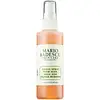What's inside
What's inside
 Benefits
Benefits

 Concerns
Concerns

 Ingredients Side-by-side
Ingredients Side-by-side

Water
Skin ConditioningPropylene Glycol
HumectantAloe Barbadensis Leaf Juice
Skin ConditioningRosa Canina Bud Extract
Skin ConditioningThymus Vulgaris Leaf Extract
Skin ProtectingFucus Vesiculosus Extract
EmollientGardenia Florida Fruit Extract
Skin ConditioningCaprylyl Glycol
EmollientHexylene Glycol
EmulsifyingPolysorbate 20
EmulsifyingParfum
MaskingPhenoxyethanol
PreservativeSodium Chloride
MaskingCitronellol
PerfumingGeraniol
PerfumingCI 17200
Cosmetic ColorantCI 42090
Cosmetic ColorantWater, Propylene Glycol, Aloe Barbadensis Leaf Juice, Rosa Canina Bud Extract, Thymus Vulgaris Leaf Extract, Fucus Vesiculosus Extract, Gardenia Florida Fruit Extract, Caprylyl Glycol, Hexylene Glycol, Polysorbate 20, Parfum, Phenoxyethanol, Sodium Chloride, Citronellol, Geraniol, CI 17200, CI 42090
Water
Skin ConditioningPropylene Glycol
HumectantSalvia Officinalis Flower/Leaf/Stem Water
MaskingCitrus Aurantium Amara Flower Water
MaskingThymus Vulgaris Leaf Extract
Skin ProtectingSalvia Officinalis Leaf Extract
CleansingAloe Barbadensis Leaf Juice
Skin ConditioningFucus Vesiculosus Extract
EmollientPropanediol
SolventEthylhexylglycerin
Skin ConditioningBenzophenone-4
UV AbsorberParfum
MaskingSodium Chloride
MaskingCitric Acid
BufferingPotassium Sorbate
PreservativeSodium Benzoate
MaskingHexyl Cinnamal
PerfumingLimonene
PerfumingLinalool
PerfumingCI 16035
Cosmetic ColorantCI 19140
Cosmetic ColorantCI 15985
Cosmetic ColorantWater, Propylene Glycol, Salvia Officinalis Flower/Leaf/Stem Water, Citrus Aurantium Amara Flower Water, Thymus Vulgaris Leaf Extract, Salvia Officinalis Leaf Extract, Aloe Barbadensis Leaf Juice, Fucus Vesiculosus Extract, Propanediol, Ethylhexylglycerin, Benzophenone-4, Parfum, Sodium Chloride, Citric Acid, Potassium Sorbate, Sodium Benzoate, Hexyl Cinnamal, Limonene, Linalool, CI 16035, CI 19140, CI 15985
 Reviews
Reviews

Ingredients Explained
These ingredients are found in both products.
Ingredients higher up in an ingredient list are typically present in a larger amount.
Aloe Barbadensis Leaf Juice comes from leaves of the aloe plant. Aloe Barbadensis Leaf Juice is best known for helping to soothe sunburns. It is also anti-inflammatory, moisturizing, antiseptic, and can help heal wounds.
Aloe is packed with good stuff including Vitamins A, C, and E. These vitamins are antioxidants, which help fight free-radicals and the damage they may cause. Free-radicals are molecules that may damage your skin cells, such as pollution.
Aloe Barbadensis Leaf Juice also contains sugars. These sugars come in the form of monosaccharides and polysaccharides, folic acid, and choline. These sugars are able to help bind moisture to skin.
It also contains minerals such as calcium, 12 anthraquinones, fatty acids, amino acids, and Vitamin B12.
Learn more about Aloe Barbadensis Leaf JuiceFucus Vesiculosus Extract is derived from a type of brown algae.
Algae is an informal term for a group of aquatic organisms that can photosynthesize. It is estimated there are at least 30,000 types of Algae.
Fucus Vesiculosus Extract contains antioxidants. Antioxidants help fight free-radicals. Free-radicals are molecules that may damage your skin cells, such as pollution.
Fucus Vesiculosus Extract is also rich in sodium, potassium, and amino acids.
Many different types of algae have different benefits.
Learn more about Fucus Vesiculosus ExtractParfum is a catch-all term for an ingredient or more that is used to give a scent to products.
Also called "fragrance", this ingredient can be a blend of hundreds of chemicals or plant oils. This means every product with "fragrance" or "parfum" in the ingredients list is a different mixture.
For instance, Habanolide is a proprietary trade name for a specific aroma chemical. When used as a fragrance ingredient in cosmetics, most aroma chemicals fall under the broad labeling category of “FRAGRANCE” or “PARFUM” according to EU and US regulations.
The term 'parfum' or 'fragrance' is not regulated in many countries. In many cases, it is up to the brand to define this term.
For instance, many brands choose to label themselves as "fragrance-free" because they are not using synthetic fragrances. However, their products may still contain ingredients such as essential oils that are considered a fragrance by INCI standards.
One example is Calendula flower extract. Calendula is an essential oil that still imparts a scent or 'fragrance'.
Depending on the blend, the ingredients in the mixture can cause allergies and sensitivities on the skin. Some ingredients that are known EU allergens include linalool and citronellol.
Parfum can also be used to mask or cover an unpleasant scent.
The bottom line is: not all fragrances/parfum/ingredients are created equally. If you are worried about fragrances, we recommend taking a closer look at an ingredient. And of course, we always recommend speaking with a professional.
Learn more about ParfumPropylene Glycol is an odorless, colorless liquid. As a humectant, it helps skin retain moisture. It also aids in delivering active ingredients.
Another role of this ingredient is preventing a product from melting or freezing. Propylene glycol also adds antimicrobrial properties to a product, elongating product lifespan.
This ingredient is considered an organic alcohol and commonly added into both cosmetics and foods.
Those with sensitive skin or conditions may develop a rash when using this ingredient.
Learn more about Propylene GlycolChances are, you eat sodium chloride every day. Sodium Chloride is also known as table salt.
This ingredient has many purposes in skincare: thickener, emulsifier, and exfoliator.
You'll most likely find this ingredient in cleansers where it is used to create a gel-like texture. As an emulsifier, it also prevents ingredients from separating.
There is much debate on whether this ingredient is comedogenic. The short answer - comedogenic ratings don't tell the whole story. Learn more about comegodenic ratings here.
The concensus about this ingredient causing acne seems to be divided. Research is needed to understand if this ingredient does cause acne.
Scrubs may use salt as the primary exfoliating ingredient.
Learn more about Sodium ChlorideWe don't have a description for Thymus Vulgaris Leaf Extract yet.
Water. It's the most common cosmetic ingredient of all. You'll usually see it at the top of ingredient lists, meaning that it makes up the largest part of the product.
So why is it so popular? Water most often acts as a solvent - this means that it helps dissolve other ingredients into the formulation.
You'll also recognize water as that liquid we all need to stay alive. If you see this, drink a glass of water. Stay hydrated!
Learn more about Water